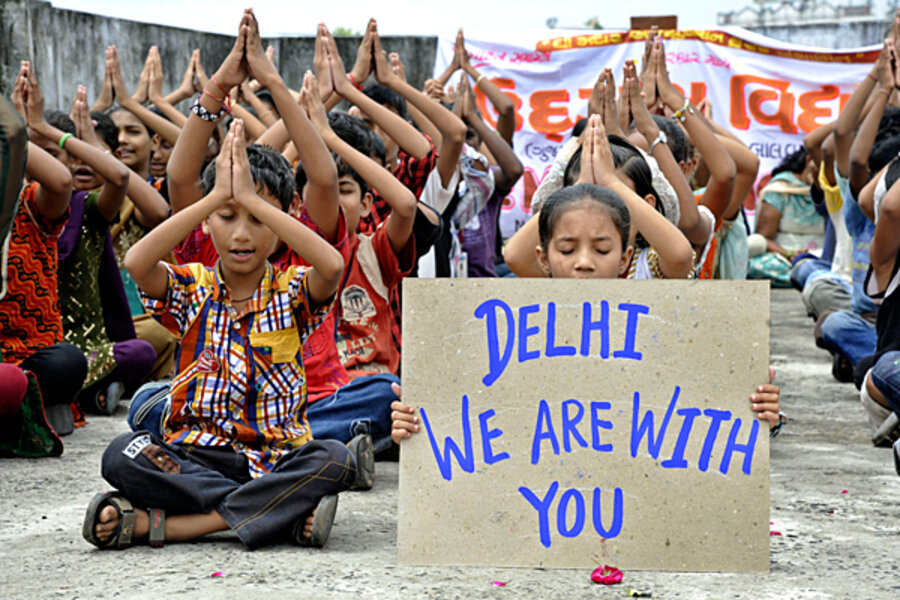India's deadly terror attacks: What happens when the spotlight fades?
| New Delhi
The long string of terrorist attacks in India over the past decade have filled newspaper headlines with concerns over the country's failure to track down and stop the menace. But often lost in the security debate is the struggle of the victims' families long beyond the funerals and fading headlines.
A bomb blast at a crowded market in New Delhi cut in half the Dass family in 2005. With their son, daughter-in-law, and grandson killed, Baghwan and Saleena Dass now raise their young grandchild and sole descendant, Manisha.
Like many Indian elderly, they had been living with their son and relying on his salary until he was suddenly killed. In the aftermath, politicians promised the family they would not have to worry about the expenses of raising Manisha, but the only government money came in a lump sum available far in the future.
“I would like to move on ahead in life and concentrate on Manisha’s future. That is my constant worry,” says Mr. Dass. “I have become very insecure. I cannot predict the kind of expenses that will have to be borne.”
After every major terror attack the Indian government promises to help ease the sudden financial burden faced by victims' families. But families such as the Dass's say the government does little beyond an initial lump sum that doesn't fit their ongoing needs. Researchers working on the long-term plight of terror victims here are urging the government take a longer-term, more comprehensive approach to their care.
“They should at least take care of the health and education costs comprehensively. These are the areas that are making families most vulnerable,” says Jacquleen Joseph, associate professor at the Tata Institute of Social Sciences in Mumbai.
Her group of researchers have set up a model program to help the survivors of the Nov. 26, 2008 Mumbai attacks using money donated by the Taj Public Service Welfare Trust.
The program works with the families of those lost in terror attacks over the long-term, helping to pay for skill training and the setup of small enterprises that will restore economic security. They also offer therapeutic groups and organize health camps tailored around the services needed by the survivors.
None of this happened for the Dass family.
At first, reporters, politicians, neighbors, and perfect strangers paid many visits. The politicians promised financial help. The state gave 750,000 rupees ($16,250) for daughter-in-law Sunita Micheal and grandson Alvin Micheal, but nothing for their son Micheal since his body was never found. The money went into a fixed deposit that Manisha will receive when she turns 18 in 2015.
Few people in India have insurance or retirement benefits, relying instead on family in the absence of social safety nets. When breadwinners in a family get killed in high-profile deaths, the government will then step in to provide some assistance.
The standard government response of offering large lump sums like the Dass family received is not sufficient, argues Joseph. In order to access the money quickly, many families take out loans against – and lose a significant portion to – interest payments. Families don’t always know how to handle the money well and sometimes bicker over it.
The Dass’s have not opted to tap the money through a loan, but that leaves them with little to provide for Manisha until she becomes an adult. And their old age and first-hand experience with sudden death leaves them fearful of the future.
“The only thing that worries me night and day is how on earth will Manisha take care of herself if God forbid something happens to us?” says Dass, a retired foreman with Air India. He will watch his wife and Manisha from the balcony when they head to the market for groceries. In general, the family avoids going out all three together. “I lost three of them last time, what if it happens again?”
The most common offer of help isn’t money, but to adopt Manisha. But the suggestion of giving up their sole descendant pains them and they suspect the offers to be schemes to market her for sympathy donations.
While the Dass’s have grown more suspicious of people after the blast and the false promises of help, some people have also impressed them. After the blast, a television reporter asked Manisha what is the one thing she likes a lot, and she said she loved to dance. She added that her favorite dancer was Birju Maharaj, who happened to see the spot and is now giving her free Khatak lessons at his academy.
Manisha does not dream of being a professional dancer. Instead, she has set her sights on becoming a police officer.
“I have seen much of terror in India, which happened to me and happened to other people who have lost their parents, brothers, sisters, sons, daughters. So I just want to stop this terror,” she explains.





